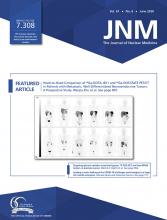Abstract
Studies demonstrate that the investigational 64Cu-DOTATATE radiopharmaceutical may provide diagnostic and logistical benefits over available imaging agents for patients with somatostatin receptor (SSTR)–positive neuroendocrine tumors (NETs). Accordingly, we aimed to prospectively determine the lowest dose of 64Cu-DOTATATE that facilitates diagnostic-quality scans and evaluated the diagnostic performance and safety in a phase III study of patients with SSTR-expressing NETs. Methods: A dose-ranging study was conducted on 12 patients divided into 3 dose groups (111 MBq [3.0 mCi], 148 MBq [4.0 mCi], and 185 MBq [5.0 mCi] ± 10%) to determine the lowest dose of 64Cu-DOTATATE that produced diagnostic-quality PET/CT images. Using the 64Cu-DOTATATE dose identified in the dose-ranging study, 3 independent nuclear medicine physicians who were masked to all clinical information read PET/CT scans from 21 healthy volunteers and 42 NET-positive patients to determine those with disease or no disease, as well as those with localized versus metastatic status. Masked-reader evaluations were compared with a patient-specific standard of truth, which was established by an independent oncologist who used all previously available pathology, clinical, and conventional imaging data. Diagnostic performance calculated for 64Cu-DOTATATE included sensitivity, specificity, negative predictive value, positive predictive value, and accuracy. Inter- and intrareader reliability, as well as ability to differentiate between localized and metastatic disease, was also determined. Adverse events were recorded from 64Cu-DOTATATE injection through 48 h after injection. Results: The dose-ranging study identified 148 MBq (4.0 mCi) as the optimal dose to obtain diagnostic-quality PET/CT images. After database lock, diagnostic performance from an initial majority read of the 3 independent readers showed a significant 90.9% sensitivity (P = 0.0042) and 96.6% specificity (P < 0.0001) for detecting NETs, which translated to a 100.0% sensitivity and 96.8% specificity after correcting for an initial standard-of-truth misread. Excellent inter- and intrareader reliability, as well as ability to distinguish between localized and metastatic disease, was also noted. No adverse events were related to 64Cu-DOTATATE, and no serious adverse events were observed. Conclusion: 64Cu-DOTATATE PET/CT is a safe imaging technique that provides high-quality and accurate images at a dose of 148 MBq (4.0 mCi) for the detection of somatostatin-expressing NETs.
Footnotes
Published online Jan. 10, 2020.
- © 2020 by the Society of Nuclear Medicine and Molecular Imaging.







